| 1. |
O’Callaghan FJ, Shiell AW, Osborne JP, et al. Prevalence of tuberous sclerosis estimated by capture-recapture analysis. Lancet, 1998, 351(9114): 1490.
|
| 2. |
Curatolo P, Bombardieri R, Jozwiak S. Tuberous sclerosis. Lancet, 2008, 372(9639): 657-668.
|
| 3. |
Chu-Shore CJ, Major P, Camposano S, et al. The natural history of epilepsy in tuberous sclerosis complex. Epilepsia, 2010, 51(7): 1236-1241.
|
| 4. |
Curatolo P, Nabbout R, Lagae L, et al. Management of epilepsy associated with tuberous sclerosis complex: Updated clinical recommendations. Eur J Paediatr Neurol, 2018, 22(5): 738-748.
|
| 5. |
Northrup H, Krueger DA, International Tuberous Sclerosis Complex Consensus Group. Tuberous sclerosis complex diagnostic criteria update: recommendations of the 2012 International Tuberous Sclerosis Complex Consensus Conference. Pediatr Neur, 2013, 49(4): 243-254.
|
| 6. |
Kwan P, Arzimanoglou A, Berg AT, et al. Definition of drug resistant epilepsy: consensus proposal by the ad hoc task force of the ILAE commission on therapeutic strategies. Epilepsia, 2010, 51(6): 1069-1077.
|
| 7. |
王艳, 张晓鑫, 杨清成. 丙戊酸钠和苯妥英钠联合治疗对难治性癫痫患者痫样放电及认知功能的影响. 新乡医学院学报, 2018, 35(2): 114-117.
|
| 8. |
李利军, 等. 药品不良反应严重程度分级评分标准的制定及药品不良反应严重度指数的应用. 药学服务与研究, 2008, 8(1): 9-13.
|
| 9. |
Cusmai R, Moavero R, Bombardieri R, et al. Long-term neurological outcome in children with early-onset epilepsy associated with tuberous sclerosis. Epilepsy Behav, 2011, 22(4): 735-739.
|
| 10. |
Jozwiak S, Slowinska M, Borkowska J, et al. Preventive antiepileptic treatment in tuberous sclerosis complex: long-term, prospective trial. Pediatr Neurol, 2019, 101: 18-25.
|
| 11. |
Zeng LH, Xu L, Gutmann DH, et al. Rapamycin prevents epilepsy in a mouse model of tuberous sclerosis complex. Ann Neurol, 2008, 63(4): 444-453.
|
| 12. |
Meikle L, Pollizzi K, Egnor A, et al. Response of a neuronal model of tuberous sclerosis to mammalian target of rapamycin (mTOR) inhibitors: effects on mTORC1 and Akt signaling lead to improved survival and function. J Neurosci, 2008, 28(21): 5422-5432.
|
| 13. |
French JA, Lawson JA, Yapici Z, et al. Adjunctive everolimus therapy for treatment-resistant focal-onset seizures associated with tuberous sclerosis (EXIST-3): a phase 3, randomised, double-blind, placebo-controlled study. Lancet, 2016, 388(10056): 2153-2163.
|
| 14. |
Galanopoulou AS, Gorter JA, and Cepeda C. Finding a better the mTOR pathway as an antiepileptogenic target. Epilepsia, 2012, 53(7): 1119-1130.
|
| 15. |
Curatolo P, Moavero R. mTOR inhibitors in tuberous sclerosis complex. Curr Neuropharmacol, 2012, 10(4): 404-415.
|
| 16. |
Song J, Swallow E, Said Q, et al. Epilepsy treatment patterns among patients with tuberous sclerosis complex. J Neurol Sci, 2018, 391: 104-108.
|
| 17. |
Overwater IE, Bindels-de Heus K, Rietman AB, et al. Epilepsy in children with tuberous sclerosis complex: chance of remission and response to antiepileptic drugs. Epilepsia, 2015, 56(8): 1239-1245.
|
| 18. |
Koene LMC, van Grondelle SE, Proietti Onori M, et al. Effects of antiepileptic drugs in a new TSC/mTOR-dependent epilepsy mouse model. Ann Clin Transl Neurol, 2019, 6(7): 1273-1291.
|
| 19. |
Combes FP, Baneyx G, Coello N, et al. Population pharmacokinetics-pharmacodynamics of oral everolimus in patients with seizures associated with tuberous sclerosis complex. J Pharmacokinet Pharmacodyn, 2018, 45(5): 707-719.
|
| 20. |
Thiele EA, Bebin EM, Bhathal H, et al. Add-on cannabidiol treatment for drug-resistant seizures in tuberous sclerosis complex: A placebo-controlled randomized clinical trial. JAMA Neurol, 2021, 78(3): 285-292.
|




